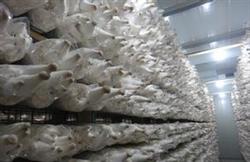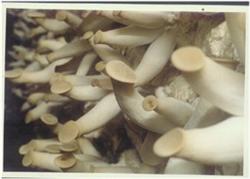Key points of management of mushroom emergence period of Pleurotus eryngii

The emergence temperature of Pleurotus eryngii varies with the characteristics of the strain. Generally, the indoor temperature is about 10 ℃ and the best temperature is 7 ℃ ~ 15 ℃. 1. Urge Lei. After the completion of post-ripening treatment, the use of temperature difference stimulation, especially in early winter, the bacterial bag after low temperature stimulation is a very necessary link, otherwise, it will lead to difficulties in budding. If the stimulation is appropriate, the white spot primordium will be formed on the surface of the bag material after about 10 days. Measures should be taken to reduce the greenhouse temperature appropriately when planting in autumn, and to increase it in spring planting, and slightly increase the ventilation rate to keep the original shed wet. After the primordium appears, the control shed is wet to 95%, enlarge the temperature difference as far as possible, the light intensity is 1000 lux, and have a small amount of ventilation, cut off the lid or turn the bag over to reveal the material surface. The number of primordia increased continuously, then differentiated and the young buds appeared. At this stage, the greenhouse temperature should be strictly controlled below 20 ℃. two。 The budding stage. The young buds are weak and require more strict and stable environmental conditions. at this stage, the temperature of the greenhouse can be stabilized at about 15 ℃, 90% humidity, 95%, 500 lux, 700 lux, and a small amount of ventilation to maintain a cool, high humidity, weak light and fresh air environment. About 3-5 days, the young buds differentiate into young mushrooms, and the basic shape of the fruiting body can be seen. 3. Young mushroom stage. The ability of young mushroom to resist external adverse factors is still weak, and it is still necessary to maintain stable temperature, water, gas and other conditions at this stage. in order to accelerate its growth speed and its robust degree, the illumination can be appropriately increased to 800 lux, but with the increase of light, the color of the fruiting body will become darker, so it is necessary to master it appropriately. About 13 ℃ can be transferred to the mushroom stage after about 7 days. The stage of young buds and young mushrooms is the main stage of shrinkage and death, and the main reason is that the temperature is too high or too low, especially the first tide mushrooms planted in autumn and the second tide mushrooms planted in spring are in the environment of large temperature difference, a little negligence or improper measures in management, untimely management, etc., will make the greenhouse temperature rise or drop sharply. Once it is less than 8 ℃ or more than 22 ℃, the young buds will yellowing, shrinking, and then die. Therefore, according to the biological characteristics of each strain, strictly and effectively regulate various conditions, correctly deal with the contradiction among temperature, air, water and light, make each stage of the fruiting body in a more suitable environment, and minimize the mortality rate, it has become the evaluation standard of mushroom stage management. 4. The mature stage of mushroom. In order to obtain high quality fruit body, we should create conditions to reduce the temperature of the greenhouse to about 15 ℃, control the humidity of the greenhouse to about 90%, reduce the illuminance to 500 lux, and increase ventilation as much as possible, but do not blow the fruit body with strong wind, especially the wind with large temperature difference. When the wind is strong, cotton gauze can be hung and wet at the doors, windows and ventilation holes, or the air inlet can be reduced, which can not only ensure the fresh air in the shed, but also coordinate the balance among air, temperature and water, which will make the fruit body under more suitable conditions. so as to grow healthily and normally. 5. Harvest. When the fruiting body is basically grown, the base is raised but not soft, the cap is basically flat and concave in the center, and the edge is basically flat but not yet ejected spores, it can be harvested in time, about medium well at this time. If the production volume is large, you can master the harvest of medium well. 6. Post-harvest management. Clean the mushroom noodles and clean the mushroom shed, spray pyrethroids insecticidal drugs once when the mushrooms come out in spring, block the light in a closed way, make the bacteria bags recuperate and recuperate, and only spray Sepi09 and other germicidal drugs once in the early winter season. After the primordium is reproduced, the mushroom production management can be repeated. Generally, the biological efficiency of Pleurotus ostreatus is 80%-120%, the biological efficiency of bowling ball-like strain is about 80%, and the commodity rate is 80%-90%. If the post-ripening management of mycelium is in place, only one tide at most two tide mushrooms can reach a more ideal yield level.
- Prev

Bud thinning technique of Pleurotus eryngii
During the cultivation of Pleurotus eryngii, the mushroom farmers did not take the necessary bud thinning in time, which led to the growth of many small mushroom buds on both sides of the bag after primordium differentiation. However, due to the limitations of nutrition and space, most of these mushroom buds can not grow into commercial mushrooms, losing the commodity price.
- Next

Cultivation of Pleurotus eryngii with high yield in winter and spring
Cultivation of Pleurotus eryngii in winter and spring is not only easy to produce high yield, but also plump, tender, delicious and nutritious, which is welcomed by consumers. The main techniques for high-yield cultivation of Pleurotus eryngii in winter and spring are as follows: First, the cultivation time from sowing to fruiting takes about 50 days to 60 days, and generally can be arranged from October to February of the following year.
Related
- Fuxing push coffee new agricultural production and marketing class: lack of small-scale processing plants
- Jujube rice field leisure farm deep ploughing Yilan for five years to create a space for organic food and play
- Nongyu Farm-A trial of organic papaya for brave women with advanced technology
- Four points for attention in the prevention and control of diseases and insect pests of edible fungi
- How to add nutrient solution to Edible Fungi
- Is there any good way to control edible fungus mites?
- Open Inoculation Technology of Edible Fungi
- Is there any clever way to use fertilizer for edible fungus in winter?
- What agents are used to kill the pathogens of edible fungi in the mushroom shed?
- Rapid drying of Edible Fungi

